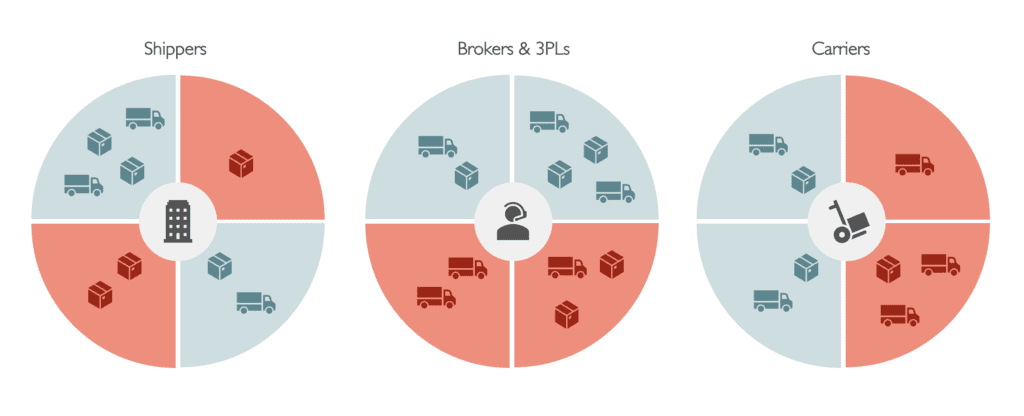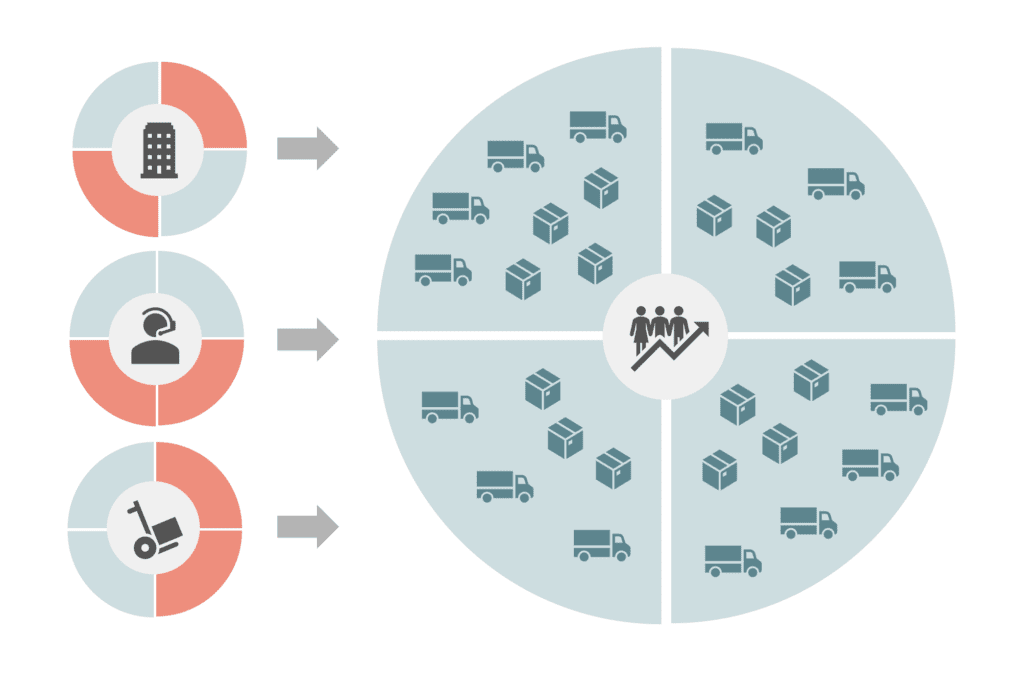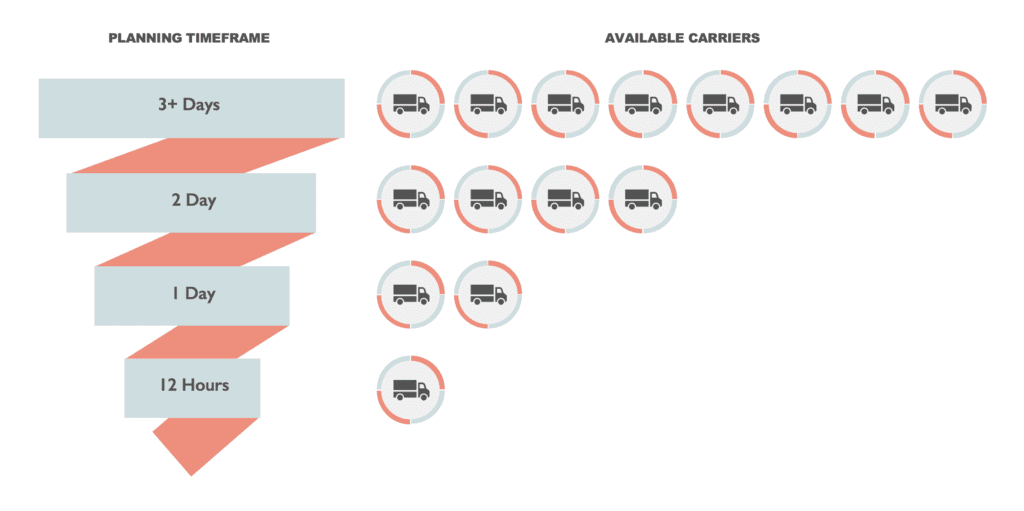 The over-the-road capacity challenges of the last year have caused a lot of shippers to rethink their carrier acquisition and retention strategies. While the capacity situation is better than in 2018, the capacity challenge never goes away and carriers across the board have learned to become more particular about which shippers they will do business with. Leading shippers and logistics services providers (LSPs) have realized that price beat down, erratic volumes and poor coordination dramatically reduce the carrier options and ultimately impact their service. One strategy, becoming the “shipper of choice”, has gained a lot of traction and there are many reasons why shippers should adopt it. I believe most shippers and LSPs will and that’s the problem – how do you differentiate yourself in securing quality transportation capacity when everyone else is doing the same thing?
The over-the-road capacity challenges of the last year have caused a lot of shippers to rethink their carrier acquisition and retention strategies. While the capacity situation is better than in 2018, the capacity challenge never goes away and carriers across the board have learned to become more particular about which shippers they will do business with. Leading shippers and logistics services providers (LSPs) have realized that price beat down, erratic volumes and poor coordination dramatically reduce the carrier options and ultimately impact their service. One strategy, becoming the “shipper of choice”, has gained a lot of traction and there are many reasons why shippers should adopt it. I believe most shippers and LSPs will and that’s the problem – how do you differentiate yourself in securing quality transportation capacity when everyone else is doing the same thing?
In the 2019 Transportation Management Strategies of Top Performers Benchmark we conducted, the respondents cited that:
- Capacity was still their greatest concern; and
- Their top strategies for addressing it were “invest in technology” and “look for new transportation services providers.”
There are a lot of technology companies chasing the holy grail of #2 but few are going to have an approach that fundamentally improves carrier capacity and resiliency for shippers and LSPs. Here are the 6 capacity matching concepts that are required for a solution to make a difference.
Trapped capacity creates market inefficiency. Every day, shippers, LSPs and carriers have an imbalance of supply and demand on a local level (see figure 1). You would think the largest shippers, LSPs and carriers would dominate the industry and scale to solve this problem. These are big companies in their own right, but small in the overall transportation market, representing single digit volumes. The reality is that no one company can solve the imbalance on their own.
Figure 1. The Trapped Capacity Problem
Leverage the network effect. Pooling transportation resources allows the participants to take advantage of the collective imbalances other members have to more effectively leverage the capacity that exists (see Figure #2).
Figure 2. The Network Effect
Enhance, not disintermediate to rapidly create scale. There is a lot of talk about how, through new load matching platforms, shippers, LSPs and carriers will open up their networks to others and share capacity. The basic premise behind this assumption is that, by and large, transportation is transactional. This premise is false – transportation is relational. Transportation is a multi-party process where the parties are relying on each other and where established relationships result in greater stability, knowledge and, ultimately, performance. It’s why so many shippers and LSPs have core or strategic carrier programs. It’s also what carriers want – predictability and the ability to maximize the utilization of their fleet. Disruption also does not necessarily mean rapid change. The transportation market is highly fragmented and consists of a complex set of relationships. To grow quickly, the network has to be a way for companies to work with others in ways that are familiar to them and feel that they are in control of their participation. The network shouldn’t be an “all or nothing” approach. Many shippers, LSPs and carriers have strong relationships and no interest in exposing them to others. Instead, the shared approach needs to allow participants to determine what they want to share.
Open, agnostic platform. The transportation data needed to create a large-scale network effect comes from a variety of sources, ELDs, real-time truck tracking solutions, TMSs, etc. The matching platform has to be able to accommodate multiple sources and normalize it into a common view. Proprietary, solutions that only use their own truck tracking data will never provide volume of shipments for the parties to maximize their load matching capabilities.
Forward looking load matching. To gain the greatest opportunity to combine open loads with trucks, the capacity matching has to be predictive, not reactive. Simply put, the longer the horizon to match loads the greater the number of options, and better service and pricing. From our experience, the number of options rises significantly when the matching horizon gets to 2 or 3 days into the future (see Figure 3). It’s also consistent with shippers and LSPs moving freight with extended load planning horizons.
Figure 3. Forward Looking Load Matching
Pattern recognition to find partners, not just match loads. If network-based load matching were just a “find a home for this load I have” then we might as well call it a better load board. Load boards were one of the pioneers of the network effect in transportation, but still represent a small segment of the market because they are just transactional relationships. One of the most powerful uses of GPS-based real-time truck data gathered across multiple parties is that shippers and LSPs can identify shipping trends that can lead to new carrier relationships. Through visualization tools newly carriers that are regularly moving through freight lanes can be discovered to enhance and establish longer term capacity.
The “Bomb Cyclone” or “Polar Vortex” that was the 2018 capacity crisis has caused shippers and LSPs to rethink their approach to attracting and retaining carriers. Rather than go it alone, leveraging a network-based capacity matching platform can make a significant difference. How much? How about 4X more matching opportunities and 16X more historic data points for carrier identification. How is your company improving its carrier capacity and resiliency? Let me know.
As Executive Vice President, Marketing and Services, Chris Jones (CJones@descartes.com) is primarily responsible for Descartes marketing activities and implementation of Descartes’ solutions. Chris has over 30 years of experience in the supply chain market, including the last 10 years as a part of the Descartes leadership team. Prior to Descartes, he has held a variety of senior management positions in other organizations including: Senior Vice President at The Aberdeen Group’s Value Chain Research division, Executive Vice President of Marketing and Corporate Development for SynQuest and Vice President and Research Director for Enterprise Resource Planning Solutions at The Gartner Group and Associate Director Operations & Technology for Kraft Foods.



















